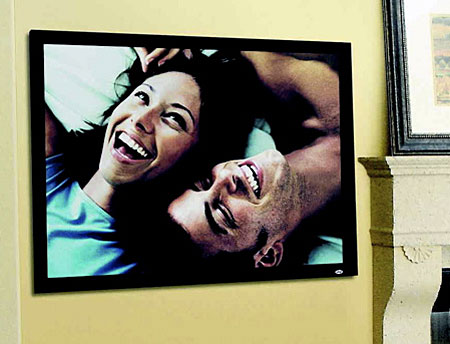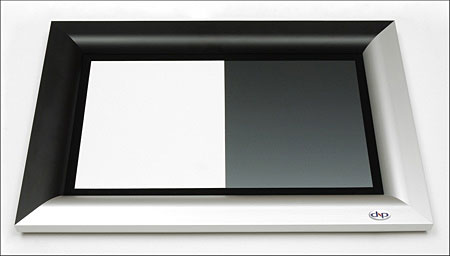DNP Supernova Projection Screen

Still projector manufacturers salivate over the possibility of any development that will make it practical to view their products in a room with significant ambient light. Video projectors are a tiny slice of the total home video display market, and an increase of only a few percent in market share would be a huge boost for that segment of the industry.
Screen manufacturers are scrambling to oblige. Screens that help at least a little in overcoming ambient light, using high gain and/or, special design characteristics, have been available for some time. But overcoming ambient light has never been primary objective of such screens. The first serious shot at screens promoted for use in normal room lighting was fired last year, when Sony released their HCS-80 ChromaVue screen. Available only in a single, 70-inch wide size, it operates by having good reflectivity only for the red, green, and blue colors that combine to make up a video image. Reflections are minimized at other wavelengths. The ChromaVue is designed primarily for use with Sony's Cineza VPL-HS51 LCD projector, since that projector's color points best match the screen's characteristics. In my review, however, I found that the ChromaVue also worked reasonably well with typical single-chip DLPs.
There is Another
DNP may not be a familiar name to most home theater fans, let alone the general public, but they've been in the projection screen business for some time. DNP stands for Dai Nippon Printing, and while this may be a Japanese company with an obvious interest in the printing trade, DNP employs 1,900 people in it's Display Solutions Division which manufactures LCD color filters for large flat panel LCD screens, computer monitors, back panels for Plasma's, Organic EL Displays, Shadow masks for CRT monitors, and the screens for more than 50% of the rear projection sets manufactured worldwide. The Supernova was developed in Japan and manufactured at DNP facilities in Denmark. It's a small world, after all.
DNP's entry into the ambient light screen race is the Supernova. It operates very differently from Sony's screen. Instead of rejecting only certain wavelengths of light, it rejects wavelengths that arrive from off-axis angles. The screen is most efficient at reflecting the light from the projector located straight ahead of it, and much less efficient reflecting light from other sources located to the sides and/or above it.

A split screen with a matte white screen on the left and the DNP SuperNova on the right
The Supernova is available in seven 16:9 sizes from 45" to 120" diagonal (approximately 39" to 104" wide), and also five 4:3 sizes from 45" to 100". (While 4:3 is no longer a popular aspect ratio for home theaters, the business market for front projection systems still dwarfs consumer sales.)
We were sent an 84" diagonal (73" wide) sample for review. It arrived in a huge but shallow wooden crate that was far heavier than the screen itself. The chance for damage with this packaging was small, and there was none. But plan on at least two people to remove the screen from the crate and mount it.
Two small but cleverly designed brackets are provided to fasten the screen to a wall. (I was able to use these clips, together with chains, to hang the screen from the ceiling.) Leaving aside the aesthetic panic a large, fixed, dark gray screen will induce in whomever handles the home dcor, the nonretractable Supernova is also exposed to possible damage from day-to-day household activity. DNP points out that the screen is very durable, even capable of surviving an attack from crayons or a magic marker. I did not test for this. (DNP plans to add a retractable version of the Supernova to its line—the Supernova Flex—in early May. Our sample was the rigid, nonretractable standard model).
The Specs
DNP offers some specifications for the Supernova that are frankly new to me. The specified contrast ratio of 20:1 was apparently measured under high ambient light conditions designed to simulate a typical meeting environment, using a 4x4 checkerboard test pattern and a specific screen and projector brightness. As we will see, this is considerably lower than the peak contrast ratio you can expect under more reasonable home ambient lighting conditions.
And how about a pitch of 0.065mm, with a claimed vertical resolution of 20,000 lines (100" diagonal screen, 4:3)? The pitch indicates that the screen is designed as an optical component—it's actually composed of millions of tiny lenses spaced 0.065mm apart (most screens are made from sprayed-on diffusion particles). Thus its optical resolution becomes significant. According to DNP, there is no bleeding from one of its lenses to another, unlike a conventional screen where there may be stray light across the diffusion particles.
The specified 20,000 lines is nearly 20-times the resolution of any source available to the consumer. DNP claims that its optical screen maintains image sharpness better than regular screens made up of white or gray diffusion particles. I have no way of verifying the 20,000-line resolution specification. But the specification does suggest that the screen will not negatively affect the visible resolution of the image. And I can confirm that the images on the Supernova looked very sharp. DNP also argues that the screen will not produce moiré with any projector. I saw none during my tests, but obviously haven't tried it with the vast array of projectors on the market.













































